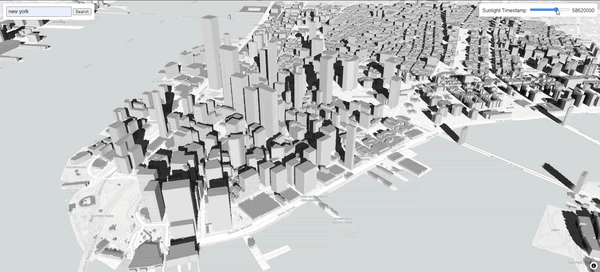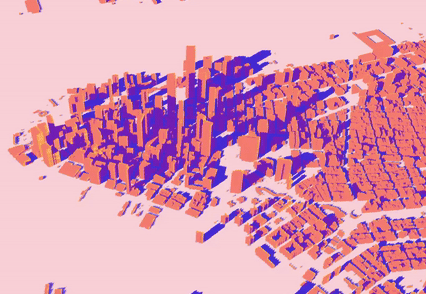Introduction
Accurate solar potential analysis requires precise shadow modeling—a challenge when dealing with large-scale city models in real time. Traditional GIS tools often rely on precomputed static shadow maps, but for dynamic sun positions and interactive analysis, we need a more flexible approach.
Leveraging Deck.gl’s WebGL-powered rendering pipeline, we implemented a custom shader-based solution to calculate real-time solar exposure on buildings. By extending Deck.gl’s built-in layers with custom GLSL shaders, we were able to:
- Compute Dynamic shadows based on the sun’s position.
- Use Normal vector dot products to determine light intensity per surface.
- Modify Fragment shaders for accurate per-pixel lighting calculations.
- Optimize real-time rendering for large-scale city models.
By integrating custom shader extensions, we fine-tuned lighting interactions and implemented shadow mapping techniques, making our solar energy assessments both scientifically accurate and computationally efficient.
Lighting in Deck.gl
Lighting in Deck.gl is fundamental for rendering realistic urban environments. By leveraging physically based lighting models and GPU-accelerated shading techniques, we ensure accurate simulation of sunlight exposure.
Types of Lighting in Deck.gl
Deck.gl provides three primary lighting models:
- AmbientLight – Uniform, directionless light that prevents complete darkness.
- DirectionalLight – Simulates sunlight with parallel rays, enabling dynamic shadows.
- PointLight – Emits light in all directions (less relevant for solar analysis).
For our project, DirectionalLight is key to accurately representing sunlight throughout the day.
const directionalLight = new DirectionalLight({
color: [255, 255, 255],
intensity: 1.0,
direction: [-1, -1, -1]
});
Shading & Material Effects
Deck.gl applies Phong shading to simulate how surfaces react to light. This involves:
- Diffuse Lighting – Reflects light based on surface angle to the light source.
- Specular Highlights – Adds realistic reflections for glass and metal.
- Ambient Reflection – Prevents pitch-black areas by simulating indirect light scattering.
Advanced Real-Time Shadow Computation
When planning solar energy systems, shadows play a critical role in determining efficiency. Rooftops and building facades may seem ideal for solar panels, but if they are shaded for most of the day, energy output drops drastically.
To solve this, we built an interactive solar potential analysis tool using Deck.gl and WebGL shaders. The goal? Simulate shadows in real time, visualize solar exposure, and estimate Building Integrated Photovoltaic (BIPV) potential dynamically.
Let’s break this down!
Sun Position & Dynamic Light Source
Shadows are entirely dependent on the sun’s azimuth and elevation, which change throughout the day. We compute these values dynamically and feed them into Deck.gl’s SunLight API, which acts as a directional light source:
import { SunLight } from '@deck.gl/core';
const sunLight = new SunLight({
timestamp: Date.now(), // Dynamic time-based sunlight
color: [255, 255, 255],
intensity: 1.0
});
This ensures that shadows shift in real time as the user adjusts the time slider, accurately reflecting sunlight exposure patterns.
Shadow Map Generation
We start by creating a framebuffer object (FBO) to store depth and color information for our shadow map. The ShadowPass class extends LayersPass to create and manage this framebuffer.
this.fbo = device.createFramebuffer({
id: 'shadowmap',
width: 1,
height: 1,
colorAttachments: [shadowMap],
depthStencilAttachment: depthBuffer
});
- Color attachment: Contains the depth map as a texture.
- Depth attachment: Ensures depth testing works correctly.
Rendering the Shadow Map
The render method resizes the framebuffer according to the viewport dimensions and clears it with a white color before rendering the shadow pass.
const clearColor = [1, 1, 1, 1];
super.render({...params, clearColor, target, pass: 'shadow'});
- Framebuffer resizing: Ensures the shadow map’s resolution matches the viewport.
- Depth test: Controlled using
depthWriteEnabledanddepthCompareparameters.
Depth Comparison in the Fragment Shader
The heart of the shadow projection technique lies in the GLSL fragment shader:
uniform sampler2D shadowMap;
varying vec4 vShadowCoord;
void main() {
float shadowDepth = texture2D(shadowMap, vShadowCoord.xy).z;
if (vShadowCoord.z > shadowDepth) {
gl_FragColor.rgb *= 0.5; // Render in shadow
}
}
- Shadow map sampling: Fetches the depth value from the shadow map.
- Depth comparison: Determines if the fragment is in shadow.
Shadow Bias Correction
A common issue in shadow mapping is shadow acne, where self-shadowing artifacts appear due to precision issues with depth comparison. We apply a small bias to the depth value to mitigate this:
float bias = 0.005;
if (vShadowCoord.z - bias > shadowDepth) {
gl_FragColor.rgb *= 0.5; // Render in shadow with bias correction
}
- Bias tuning: Must be adjusted based on the scene scale to avoid Peter Panning (shadows detaching from objects).
Percentage Closer Filtering (PCF)
To achieve soft shadows, we implement Percentage Closer Filtering (PCF), which averages multiple depth comparisons around the fragment’s shadow coordinate:
float shadow = 0.0;
vec2 texelSize = 1.0 / textureSize(shadowMap, 0);
for (int x = -1; x <= 1; x++) {
for (int y = -1; y <= 1; y++) {
float pcfDepth = texture2D(shadowMap, vShadowCoord.xy + vec2(x, y) * texelSize).z;
shadow += vShadowCoord.z > pcfDepth ? 0.3 : 1.0;
}
}
shadow /= 9.0;
gl_FragColor.rgb *= shadow;
- Texel size calculation: Ensures smooth sampling over the shadow map.
- Soft shadow effect: Creates a more realistic penumbra.
Optimizing Shadow Rendering
- Mipmapping: Enabled for the shadow map texture to improve sampling quality.
- Clamp-to-edge wrapping: Prevents artifacts at texture boundaries.
- Blending and depth testing: Configured in
getLayerParametersfor accurate depth comparison.
return {
...layer.props.parameters,
blend: false,
depthWriteEnabled: true,
depthCompare: 'less-equal'
};

Surface Normals and Dot Product in Lighting Calculations
In Deck.gl and real-time rendering, the dot product between a surface normal and a light direction vector is fundamental to determining how light interacts with surfaces. This relationship is captured using:
$$ \vec{N} \cdot \vec{L} = |\vec{N}| |\vec{L}| \cos(\theta) $$ $$ I = \max(0, \vec{N} \cdot \vec{L}) $$
Where:
- $( I )$ is the diffuse light intensity.
- $( \vec{N} )$ is the normalized surface normal vector.
- $( \vec{L} )$ is the normalized light direction vector.
In Deck.gl shaders:
vec3 normal = normalize(vNormal);
vec3 lightDir = normalize(uLightDirection);
float intensity = max(0.0, dot(normal, lightDir));
This intensity value adjusts shading dynamically, highlighting surfaces based on their orientation to the sun.
Writing Custom Shaders with Deck.gl Extensions
Deck.gl provides a powerful extension system for injecting custom WebGL shaders into its rendering pipeline. This flexibility is critical for accurate solar potential analysis.
Understanding Shader Hooks in Deck.gl
Deck.gl uses shader hooks to allow developers to modify the built-in rendering pipeline without rewriting the entire shader. A LayerExtension in Deck.gl provides a clean way to attach these hooks to existing layers. Let’s break down how this works!
Creating a Custom Shader Extension with Hooks
In the example, the HeatMapExtension class extends LayerExtension and defines shader injections via the getShaders method:
class HeatMapExtension extends deck.LayerExtension {
getShaders() {
return {
inject: {
"vs:#decl": `
varying vec3 vNormal;
`,
"vs:#main-end": `
vNormal = normalize(geometry.normal);
`,
"fs:#decl": `
varying vec3 vNormal;
uniform vec3 uLightDirection;
`,
"fs:DECKGL_FILTER_COLOR": `
vec3 lightDir = normalize(uLightDirection);
vec3 normal = normalize(vNormal);
float dotProduct = max(dot(normal, lightDir), 0.0);
vec3 colorValue = mix(vec3(0.5), vec3(1.0), dotProduct);
color = vec4(colorValue, 1.0);
`,
},
};
}
}
Explanation of Shader Hooks
vs:#decl: Injects a varying variable declaration into the vertex shader to pass normal data to the fragment shader.vs:#main-end: Captures and normalizes the surface normal from the geometry after the vertex shader’s main function.fs:#decl: Declares the varying normal vector and the uniform for the light direction in the fragment shader.fs:DECKGL_FILTER_COLOR: A Deck.gl filter hook that modifies the fragment color based on the dot product of the surface normal and light direction, simulating diffuse lighting.
Passing Uniforms to the Extension
To ensure that the custom shader extension receives the correct light direction, uniforms need to be passed explicitly to the layer using the getUniforms function. This allows dynamic updates to lighting without modifying the extension code itself.
const lightDirection = [1, 1, 1]; // Example light direction
const geoJsonLayer = new deck.GeoJsonLayer({
id: 'geojson-layer',
data: 'https://example.com/geojson',
filled: true,
extruded: true,
getFillColor: [255, 255, 255],
getElevation: f => f.properties.height || 0,
pickable: true,
shadowEnabled: true,
extensions: [new HeatMapExtension()],
parameters: { depthTest: true },
getUniforms: () => ({
uLightDirection: lightDirection,
}),
});
new deck.DeckGL({
container: 'container',
initialViewState: {
longitude: 72.5714,
latitude: 23.0225,
zoom: 12,
pitch: 45,
bearing: 0,
},
controller: true,
layers: [geoJsonLayer],
});
By leveraging the getUniforms function, the light direction can be dynamically passed to the shader, enabling responsive and interactive visualizations without needing to hard-code these values in the shader code itself.
Conclusion
By customizing Deck.gl’s shader pipeline, we achieved real-time, GPU-accelerated shadow modeling for urban-scale solar analysis. The ability to dynamically compute light exposure, surface shading, and shadows ensures a precise evaluation of BIPV and rooftop solar potential.
This approach empowers researchers, urban planners, and policymakers to interactively explore solar energy potential, making informed decisions on optimal photovoltaic placements. As WebGL and GPU computing continue to evolve, such shader-based methodologies will become essential tools in the future of urban energy modeling and sustainability planning.
Citation
@article{CustomShader,
title = "Running Custom WebGL Shaders Using Deck.gl for Solar Potential Analysis.",
author = "Atharva Garole | Prathamesh Badgujar | Sagar Singh",
journal = "solar-vortex.github.io",
year = "2025",
month = "February",
url = "https://solar-vortex.github.io/blog/post/customshaders/"
}
